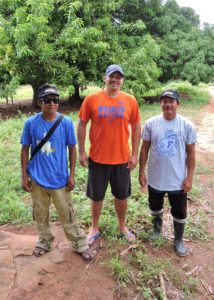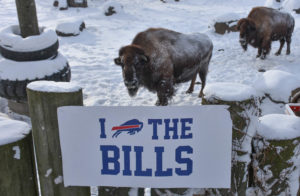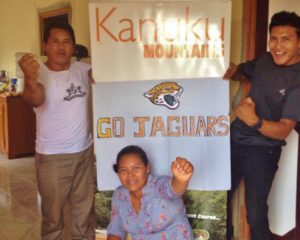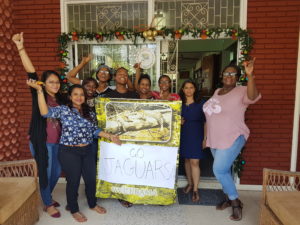Friendly wager on American football results in support of jaguar conservation in Guyana

While American football may not be very popular in Guyana, some Guyanese were watching the outcome of last week’s first-round playoff game between the Jacksonville Jaguars (Florida, USA) and Buffalo Bills (New York, USA) very closely. In the spirit of friendly competition, and to celebrate both teams gaining NFL playoff berths for the first time in many years, the Jacksonville Zoo and Gardens (Florida) teamed up with the Buffalo Zoo (New York) for a friendly wager with the goal of bringing attention to two conservation projects that the zoos are passionate about. One of those projects operates right here in Guyana and just happens to share its focus with one of the team’s mascots.
The bet
The wager was simple. If the Buffalo Bills won, the Jacksonville Zoo and Gardens would make a contribution to the North American Bison Coalition in addition to supplying the Buffalo Zoo with chocolate-covered popcorn (a local delicacy). The American Bison Coalition brings together an assortment of conservationists including Native America tribes, educators, and zoos in an effort to raise awareness of this iconic species in North America. If Jacksonville won, the Buffalo Zoo would contribute to the Rupununi Wildlife Research Unit, as well as sending sponge candy (its local delicacy) to the Jacksonville Zoo and Gardens. The Rupununi Wildlife Research Unit is a coalition of researchers working to increase understanding and inform the management of some of Guyana’s most iconic species, including jaguars.
Imagining a matchup of North and South America’s quintessential species, Jacksonville Zoo and Gardens’ Executive Director Tony Vecchio felt confident backing his hometown jaguars, saying “as a trained zoologist, it is clear to me that a jaguar would have no trouble taking down a bison.” However, Buffalo Zoo President/CEO, Norah Fletchall, was not intimidated countering with “a jaguar may be fast and cunning, but stands little chance against a herd of well-built and winter-hardy bison.”
The North American bison (Bison bison) is the continent’s largest land mammal, with mature bulls standing more than 2 meters tall, over 3.5 meters long, and weighing up to 2,000 pounds. Despite their massive size, bison can run more than 60 KPH, jump approximately 2 meters high, and thundering herds running shoulder-to-shoulder move in unison to evade predators. The North American bison has become the symbol of conservation in the US and was named ‘America’s National Mammal’ in 2016.

A conservation success story, bison populations have rebounded within protected areas following significant declines in the late nineteenth and early twentieth centuries. An estimated 20-30 million individuals once roamed the American savannahs before conversion of native prairies to agriculture and extreme overharvest reduced their numbers to 1,091 individuals in 1889. Today, approximately 30,000 wild bison exist in conservation herds, with about 5,000 roaming unfenced and disease free across the American plains as their ancestors once did.
The jaguar (Panthera onca) is Guyana’s national animal, the largest cat in the Americas, and perhaps, pound for pound, the most powerful big cat in the world. Jaguars are efficient and effective hunters that are renowned for their stealth and power. Their ability to stalk in silence, attack with a single leap, and produce an amazing bite force relative to their weight allowed them to subdue prey much larger than themselves. Though they are the animal most often associated with the dense tropical rainforests of the Amazon and Guiana Shield, jaguars inhabit a wide variety of habitats, including wetlands, swamps, coastal forests, scrub, savannahs, and desert from the south-western United States to northern Argentina. Deforestation has resulted in about 50% reduction in the jaguar’s native range in the last 100 years and retaliatory killing following predation of livestock threatens remaining populations. Guyana remains a stronghold for South America’s most iconic species thanks to its high percentage of forest cover and active conservation efforts in the interior.
The game
In front of their home crowd at EverBank Field in Jacksonville, the Jaguars outlasted the Bills in an old-school, low scoring game between two very talented defenses. The game’s only touchdown came late in the third quarter when, with the score tied 3-3 and facing fourth-and-goal from the 1-yard line, Jaguars QB Blake Bortles found TE Ben Koyack in the back of the end zone with a gutsy pass at a critical moment. That score was all the Jaguars stout defense would need, sacking the quarterback twice, and forcing two turnovers, including the game clinching interception by CB Jalen Ramsey that kept the final score at 10-3.

The close game kept Jaguars’ fans, and jaguar researchers, at the edge of their seats. Said Rupununi Wildlife Research Unit (RWRU) founder, Dr. Matt Hallett, “I was always confident that the Jags would pull it out in the end, but I’m not going to lie and say that wasn’t nervous there for a bit … as a north-central Florida resident I was happy to see the local team win, but I’m even more grateful that the Jacksonville Zoo & Gardens and the Buffalo Zoo the game as an opportunity to raise awareness of important conservation efforts. The American Bison Coalition is doing amazing work with one of my favorite North American species, but of course, I’m thrilled that the wager will ultimately generate some benefits for our talented and hard-working research teams in the Rupununi.”
Asked whether or not the game reflected a match-up of their wild counterparts as predicted by the CEO’s of the two zoos, Hallett replied, “Ironically the low scoring nature of the game actually more closely resembled the methodical pack-hunting style of one of Guyana’s other wild carnivores, the bush dog (Speothos venaticus), which utilizes stamina to outlast and eventually overtake its prey.”
Conservation benefits
The Rupununi is widely considered the most biodiverse region of Guyana and the indigenous Makushi and Wapichan people who inhabit the region have served as its stewards for millennia. The wealth of biodiversity and natural resources that persist there today are the direct result of their traditional management systems and continued commitment to sustainable use. However, the Rupununi is currently facing dramatic social, economic, and environmental change, resulting from exposure to technology and global culture, demand from, and access to, global markets, and a changing global climate.
The overarching goal of the RWRU is to equip Rupununi communities with tools, strategies, and structures to deal with their rapidly changing world, allowing them to continue the legacy of stewardship set by previous generations. They team up with indigenous hunters, farmers, and fisherman from across the region, providing training and employment opportunities with the goal of generating a greater understanding of the distribution and abundance of jaguars and their prey. Large mammals fit as the focus of their work, as they are provide critical services at a variety of scales. Globally, large mammals are naturally rare, play important roles in ecosystems, are sensitive to disturbance, and are the majestic and regal or cute and cuddly animals that we all love. Locally, large mammals may prey on livestock or pets (jaguars, puma), damage crops (deer, agouti, peccaries), and are targeted for food (peccaries, labba, tapir, deer). Bringing together the traditional and scientific knowledge has allowed the RWRU to generate a wealth of data and co-develop new questions that they did not even know they had when they began.
The Jacksonville Zoo & Gardens has been providing financial support to the Rupununi Wildlife Research Unit for the past three years, and supporting conservation initiatives in Guyana since 2008.

Conservation is a priority for the Jacksonville Zoo and Gardens and the Buffalo Zoo, as well as all institutions that belong to the Association of Zoos and Aquariums (AZA). Collectively, AZA institutions supported about USD$216,000,000 worth of field conservation efforts in 2016. The Buffalo Zoo and Jacksonville Zoo and Gardens directly contribute to the long-term survival of species in natural ecosystems and habitats through both species-specific and habitat-focused conservation projects.
The Jacksonville Jaguars travel to Heinz Field this week to take on the Pittsburgh Steelers in their second-round playoff matchup. No word yet on whether the Jacksonville Zoo & Gardens has reached out to the Pittsburgh Zoo & PPG Aquarium for another friendly wager for the sake of conservation.
Follow Rupununi Wildlife Research Unit on Facebook, rupununiwildlife on Instagram, @RupWildlife on Twitter, or subscribe to their Rupununi Wildlife channel on YouTube. (By JJ Vitale, Jacksonville Zoo & Gardens; Christian Dobosiewicz, The Buffalo Zoo; and Matt Hallett, Rupununi Wildlife Research Unit.) (Guyana Times Sunday Magazine)



